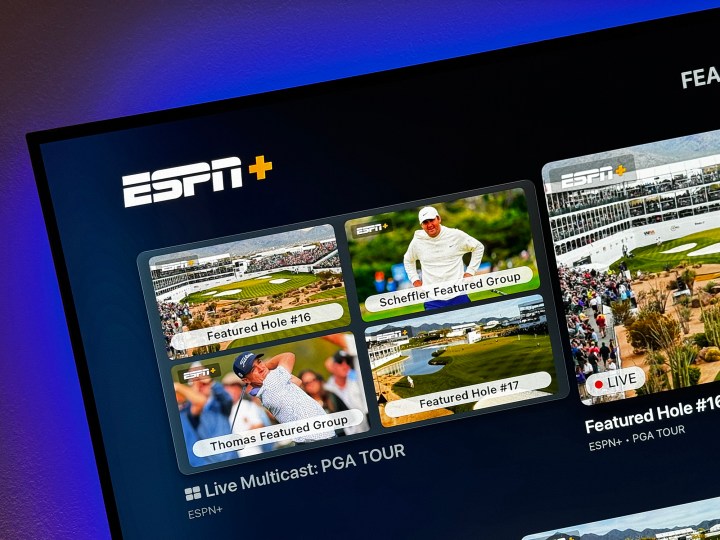
There’s a habit, when it comes to streaming television, to overcomplicate things. Why else would there be a million (more or less) articles online explaining which streaming service is “best.” (Spoiler: None.) Or articles that explain why you should get one service over another, as if it’s a zero-sum game.
This has all happened before, and it will happen again, thanks to the gods of SEO. And we can expect even more of it in the fall of 2024 when the first of a pretty major one-two punch hits the world of streaming sports. That’s when we’ll see the combined sports assets of ESPN, Fox, and Warner Bros. Discovery become available as part of a new streaming service.
Much is still unknown. A name for the service, for one thing. Price, for another. And we don’t yet know exactly when it will drop. (Disney CEO Bob Iger said “probably August,” but there’s been nothing more official than that.)
When it does come time to decide whether the new service is something you’ll want to spend money on, only two things actually matter. And they’re not complicated.
- Does the service have the content you want?
- Does it have it at a price you can afford?
It’s as simple as that.
Those are, of course, subjective considerations. The sports that are most important to me might not be of any importance to you. (And that’s OK!) And the price I’m willing to pay may well be different than what you’re OK with (or vice versa).
While this new sports trifecta doesn’t yet have a name or a price, we do at least have a pretty good sense of the actual live sports that will be available, since a press release has said so.
- Professional football: NFL, UFL
- Basketball: NBA, WNBA
- Baseball: Major League Baseball
- College sports: “Thousands of games and events” — probably starting with the multitude already on ESPN+. It’ll include the ACC, Big 10, Big 12, Big East, and SEC, with 40 NCAA championship events, plus the NCAA men’s and women’s basketball tournaments and the expanded college football playoffs.
- Golf: PGA Tour and PGA Championship, The Masters, and TGL Golf (that’s the new made-for-TV venture from Tiger Woods and Rory McIlroy).
- Tennis: Wimbledon, U.S. Open, Australian Open.
- Cycling: Giro d’Italia, UCI Mountain Bike World Cup, and Giro Donne
- Soccer: FIFA World Cup, U.S. Soccer matches, NWSL, MLS, La Liga (Italy), Bundesliga (Germany), UEFA, CONCACAF
- Auto racing: Formula 1, NASCAR, 24 Hours of Le Mans
- Combat sports: UFC, Top Rank boxing
There are no two ways about it — that’s one hell of a list. But here’s the thing: Much (if not all) of the sports listed above are available some other way, quite possibly via a subscription for which you already are paying, whether it’s via cable or via a linear streaming service like YouTube TV.
And that actually makes sense when you consider what Fox CEO Lachlan Murdoch said the day after the new sports service was announced: It’s not intended to replace what you get with a cable or streaming subscription.
“This sports-focused platform is focused entirely on not cord-cutters, but cord-nevers,” Murdoch said on the Fox earnings call. “The target for this … is really that universe of, call it, 60 million-odd households that currently don’t participate in the bundled, cable, and pay television ecosystem.”
If a service costs too much and doesn’t have what you want, why subscribe?
Disney’s Iger reiterated things that same day in his company’s earnings call, likening the new sports service to a sort of super add-on for those who don’t have some other linear TV subscription. Like, say, the live subscription you can get as part of Hulu’s on-demand package.
“If you’re a Hulu subscriber and you want to get this new sports service,” Iger said, “you can buy that as an add on to Hulu. … You add a sports feature with so many sports that this new joint venture will offer that’s very, very compelling in terms of reducing churn for Hulu and increasing engagement. So, we look at this as a huge positive for Hulu.”
In other words, they’re going after an audience that doesn’t yet subscribe to anything live. And that mostly is going to mean a younger viewing generation.
All that to say that when the time comes and this new sports service gets a price (and, ya know, a name), there really are only two things you need to worry about. (OK, maybe two and a half.) Same goes for when ESPN becomes available as a standalone subscription in fall 2025.
Does this new service have a price you can stomach? And does it have the sports you want to watch? And are you already getting those sports some other way?
It’s no more complicated than that.



